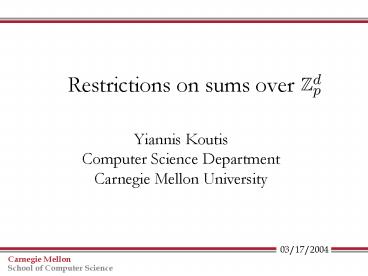Restrictions on sums over - PowerPoint PPT Presentation
Title:
Restrictions on sums over
Description:
Work on sum of vectors ... numbers of subsets of A summing up to ... how smaller can the number of zero-sum subsets be, than then number of v-sum subsets? ... – PowerPoint PPT presentation
Number of Views:111
Avg rating:3.0/5.0
Title: Restrictions on sums over
1
Restrictions on sums over
Yiannis Koutis Computer Science
Department Carnegie Mellon University
2
Vectors over
- p prime
- d dimension of the vectors
- point-wise multiplication mod p
- p 3, d3
3
Work on sum of vectors
- f(n,d) the minimum number such that every
subset of has a sub-subset that sums up to
- f(n,1) 2n-1 Erdos, Ginzburg, Ziv
- f(n,d) cd n Alon, Dubiner
- f(n,d) (9/8)d/3 (n-1)2d1 Elsholtz
- f(n,2) ? conjectured equal to 4n-3
4
dimensionality restrictions
- is an arbitrary subset of size
p(d2) - numbers of subsets of A summing up to
- what is the probability that the number of
zero-sum subsets of A is odd, when p2? - how smaller can the number of zero-sum subsets
be, than then number of v-sum subsets?
5
dimensionality restrictions
- is an arbitrary subset
- numbers of subsets of A summing up to
- what is the probability that the number of 0-sum
subsets of A is odd, when p2? prob 1 - how smaller can the number of zero-sum subsets
be, than then number of v-sum subsets? - zero is attractive worst case one less
6
motivation
- The Set Packing problem Given a collection C of
sets on a universe U of n elements, is there a
sub-collection of k mutually disjoint sets ? - Algebraization
- Assign variables xi to the elements of U
- for each set S, let
7
motivation
- Let
- If there are k disjoint terms, there is a
multilinear term. If not, fk is in the ideal
ltx12,x2,2,..gt
8
example
- Define the sets
- Then
9
motivation
- Let
- If there are k disjoint terms, there is a
multilinear term. If not, fk is in the ideal
ltx12,x2,2,..gt - Basic idea evaluate fk over a small
commutative ring with a polynomial number of
operations and exploit the squares
10
example
- Assign distinct to element i and
substitute v0xvi in xi - Then for every i
- If there is no set packing of size k, then fk is
a multiple of (1x)2 - How large must d be so that the multilinear term
is not a multiple of (1x)2 ? must be
linear, unfortunately
11
representation theory for
- each element is represented by a matrix
- addition is isomorphic to matrix multiplication
- 1-1 elements with entries
- in the first row
12
representation theory for
- The coefficient of xi in H(1,j) is the number of
vj-sum sets of cardinality i in A. - For x1, H(1,1) zero-sum1
- H(1,j) vj-sum
13
representation theory for
- All matrices ? are simultaneously diagonalizable
- V is a Hadamard matrix, every entry is 1 or -1
- ?(?) is diagonal, containing the eigenvalues
which are all 1 and -1
14
parity of zero sum subsets
- For x1, H(1,1) zero-sum1, H(1,j) vj-sum
- Each matrix (I?(?) ) has eigenvalues 0 and 2
- For d 1 terms in the product, the eigenvalues
are either 0 or 2d1. All entries of H are even. - zero-sum1 even , vj-sumeven
15
number of zero-sum subsets
- 2dH(1,1) trace(H) sum of eigenvalues
- 2dH(1,j) weight eigenvalues by 1 and -1
- H(1,1) H(1,j)
- zero is attractive zero sum 1 vj-sum
16
restrictions on sums
- Let N(v,k) be the number of v-sum subsets of
cardinality k - Theorem Given N(v,2t) mod 2,for 1 t 2log n,
the numbers N(v,2t) mod 2, for tgt2log n can be
determined completely .
17
restrictions on sums - outline
- Form
- Also
- v has only a 1 in the extra dimension
- The coefficient aj of xj in H, is zero mod 2
when j 4d - aj is a linear combination of the coefficients of
xj for j\leq 4d in H
18
restrictions on sums
- Let N(v,k) be the number of v-sum subsets of
cardinality k - Theorem Given N(v,2t) mod 2,for 1 t 2log n,
the numbers N(v,2t) mod 2, for tgt2log n can be
completely determined. - Question What are the admissible values for
the 2log n free numbers, over selections
?
19
generalizations to
20
conclusions back to motivation
- Assign distinct to element i and
substitute v0xvi in xi - Then for every i
- If there is no set packing of size k, then fk is
a multiple of (1x)2 - How large must d be so that the multilinear term
is not a multiple of (1x)2 ? must be
linear, unfortunately
21
conclusions back to motivation
- If there is no set packing of size k, then fk is
a multiple of (1x)2 - But now, we know that fk must also satisfy many
linear restrictions - Question Can we exploit this algorithmically?































